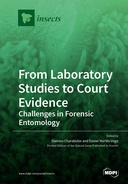Explore

From Laboratory Studies to Court Evidence: Challenges in Forensic Entomology
0 Ungluers have
Faved this Work
Login to Fave
In 2001, Benecke concluded a review on the history of forensic entomology with these optimistic words: "basic research and advanced application of forensic entomology (…) has opened the way to routine casework". At the same time, the TV show Crime Scene Investigation (CSI) largely brought forensic entomology to light. However, the show also cruelly pointed out its limits: After the team leader explained to his colleague how insects can help determine the time of death, the team leader added "You've still got to convince a jury", to which the colleague promptly responded "On guns. It's got to be better than bugs. Less Latin." Indeed, several factors—including complexity, inherent limitations, and the rapid evolution of scientific knowledge—explain the slow acceptance of insect-based evidence. In this context, this Special Issue focuses on the articulation between laboratory studies and casework, a major challenge for the future of forensic entomology.
This book is included in DOAB.
Why read this book? Have your say.
You must be logged in to comment.
Rights Information
Are you the author or publisher of this work? If so, you can claim it as yours by registering as an Unglue.it rights holder.Downloads
This work has been downloaded 204 times via unglue.it ebook links.
- 204 - pdf (CC BY) at Unglue.it.
Keywords
- accumulated degree day estimates
- ADD
- alternative storage
- animal carcass
- animal carcasses
- arthropods
- Autopsy
- bait attraction
- barcoding DNA
- biological variation
- Burial
- Cadaver
- Calliphoridae
- Carrion
- carrion insects
- Cases
- casework
- Climate Change
- cold cases
- colonisation
- confession
- cooling period
- court
- crime scene
- criminal justice systems
- criteria
- death time estimation
- decay
- decaying substrate
- Development
- Diptera
- entomological evidence
- experimental studies
- Expert witness
- expert witness statement
- Expertise
- Fanniidae
- first record
- forensic entomology
- funerary archaeoentomology
- Global warming
- hair evidence
- human cadaver
- Identification
- insect evidence
- insect succession
- Insects
- integrative taxonomy
- larva
- larval morphology
- legislation
- length-weight estimates
- limitations
- Lucilia sericata
- medico-legal entomology
- minimum postmortem interval (PMI-min)
- n/a
- pig
- PMI
- post-mortem interval
- postmortem interval
- Psychology
- rearing
- Research
- Society & Social Sciences
- Spain
- species identification
- Species interactions
- Succession
- successional studies
- TBS
- temperature
- thanatology
- thema EDItEUR::J Society and Social Sciences::JM Psychology
- time of colonization
- Validation
- vertebrate decomposition
Links
DOI: 10.3390/books978-3-0365-1707-0Editions

